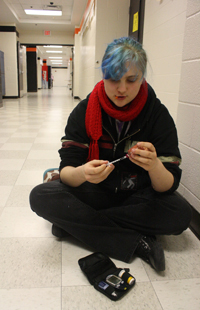Diabetes adds challenge to school day

Sophomore Athena Siskind prepares the needle she needs to regulate her insulin levels. Siskind needs to inject herself when her blood sugar levels get too high.
May 30, 2014
“I was always hungry, no matter what. I felt sick, I was peeing every half an hour, wetting the bed.” Athena Siskind, a sophomore who was diagnosed with diabetes when she was five.
Although diabetes can be a manageable disease if caught on time, it still has an impact on the afflicted throughout their daily lives.
Diabetes affects approximately 8.3% of the American population. A common misconception is that diabetes only affects the overweight and obese. While the majority of those affected do have Type 2 diabetes, for which being overweight is a risk factor, the majority of teenagers have Type 1 diabetes, which is genetic and not related to weight.
Siskind said she has definitely experienced this misconception. “I had a health teacher who said only people who are fat and lazy get diabetes,” she said. “That’s just not true.”
“I have Type 1, which means it will never go away. Common symptoms are prolonged hyperglycemia, which can cause vision loss,” explained Siskind. “Eventually, if it continues [untreated] for long enough, you’ll have to get your limbs amputated and all of your organs will fail.”
Those with diabetes have trouble maintaining their blood sugar.
“When your blood sugar is high you have a bunch of sugar in your body that you can’t use…For low blood sugar, you just need more sugar than you have.” explained Siskind. “Basically there’s treasure chests full of sugar, and you don’t have keys,” she added.
Those with diabetes can face challenges in their day-to-day school lives. “If I have high sugar or low blood sugar that test is not showing what I know because I’ll probably have a headache, my body will not be functioning properly,” said Siskind.
Low blood sugar and high blood sugar both have very different, and yet equally unpleasant immediate effects. “High blood sugar, usually I know if I have to go to the bathroom more than once an hour, or if I have a headache, or I can’t focus. Low blood sugar is often accompanied by feeling very hungry and very, very bad,” said Siskind.
If either condition lasts too long, it can severly harm the body. “If it gets low enough you can have a seizure, go into a diabetic coma or die… If you have prolonged high blood sugar your body will start to eat itself. ”
South does offer a variety of accommodations for these students. “The nurse, if you ask her to, will send an email to your teachers and [ask] ‘can you please excuse them from this test? They were not at the peak.’ I think the teachers are generally accommodating.”
Merrillee Sullivan, one of South’s nurses explained that, “There are standards of practice that we use [for students with diabetes.]” These practices include liberal bathroom privileges, the ability to enter first in the lunch line, extended time to make up work, and excused absences caused by diabetes.
“If I have extremely high blood sugar I’ll take care of it in class,” said Siskind. “If I have low blood sugar I’ll leave because I won’t be able to function or retain any information.”
Students vary in how much they need to monitor their blood sugar. Some frequently need to leave class to control their blood sugar, or due to other complications. They may obtain a 504 plan, a personalized learning plan for students with disabilities or other obstacles that prevent them from learning in the traditional manner.
While diabetes is not curable and severely inconveniences students, it is relatively easy for most students to regulate.
When students experience hyperglycemia, or high blood sugar, simply have to take insulin. Insulin is a hormone naturally excreted by the pancreas which people with diabetes either do not produce or use efficiently.
“For low blood sugar, you need to have sugar, so you can drink a non diet pop or have some glucose tabs, or juice,” said Siskind.
Students generally are able to keep their diabetes under control themselves, says Sullivan. Endocrinologists, or doctors who deal with diabetes, generally prefer this, she explained.
Dealing with diabetes is a life-long task that comes with lots of responsibility, Siskind says. She said she often worries about being able to afford all of the sugar tablets, insulin, and the other medical costs associated with diabetes later in life. “Test strips are about 60 dollars a bottle,” she said.
“Put [a test strip] in, prick your finger, check it,” explained Siskind in what she described as a “crash course” for treating diabetes. “If you [have high blood sugar] we have a nice little syringe, or if you eat you need to do that too.
Some people use pens, which is like a pen that you stab yourself with. And there’s pumps that stay on your body all the time, which reduces the scar tissue because you just keep the needle in all the time for a week.”
With recent advances in medicine diabetes is becoming more and more manageable. Many people with diabetes now choose to get an insulin pump which, as Siskind described, is a computerized device that deliver insulin into your body when needed through a semi-permanent needle placed under your skin.
Siskind said there are many misconceptions about diabetes. She says that teaching people about how diabetes works would make people more informed and diabetic people would be safer.
“ I think there needs to be information about diabetes,” she said. “A lot of people will be like ‘you’re low, do you need to take some insulin?’ And if someone were to give me insulin while was low I would die. If I go somewhere with people, I’ll tell them, if I’m low I’ll start shaking, my cognitive functions have been cut off, you need to get me sugar.
Teaching them how to use that, is something that I’ve done for some of my friends, especially if we’re sleeping over.”
As scientists and doctors develop more new treatments for diabetes the complication rate is decreasing significantly. Diabetes is becoming a disease that is easier and easier to live with.





